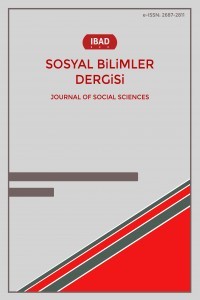Bir Olasılıktan Ötekine Köprü
Bu çalışmada öznel ve nesnel olasılıklar arasındaki işbirliği koşulları incelenmektedir. Burada işbirliği sözcüğü ile anlatılmak istenen, olasılıklardan biri belli iken öbürünü de belli etmektir. Olasılık kuramının ilk zamanlarında böyle bir sorun yoktur; çünkü o zamanlarda tek olasılık vardır, o aynı anda hem öznel hem de nesnel olasılıktır, büyük sayılar yasası onlardan birinin öbürüne eşit olmasını garanti etmektedir, bu da demektir ki olasılıklardan biri belli iken öbürü de bellidir. O günlerdeki işbirliğine mutlak işbirliği denebilir. Bugün yalnızca koşullu işbirliği kabul edilebilir niteliktedir. Bu çalışma söz konusu koşullu işbirliğini incelemeyi amaçlamaktadır.
Anahtar Kelimeler:
Olasılık, Öznel Olasılık, Nesnel Olasılık, İşbirliği
Bridge from One Probability to Another
This study examines the conditions of cooperation between subjective and objective possibilities. Here, the intended goal to express the word of collaboration is to make one probability known when the other is known. There was no such problem in the early days of probability theory; because there is only one possibility at that time, it is both subjective and objective at the same time, the law of large numbers guarantees that one of them is equal to the other, which means that while one of the probabilities is certain, the other is obvious too. Cooperation in those days can be called absolute cooperation. Today, only conditional cooperation is acceptable. This study aims to examine this conditional cooperation.
Keywords:
Probability, Subjective Probability, Objective Probability, Cooperation,
___
- Arntzenius, F ve Hall, N. (2003). On What We Know About Chance. British Journal of Philosophical Science, 54 (2), 171-179.Carnap, R. (1945a). The Two Concepts of Probability. Philosophy and Phenomenological Research, 5 (4), 513-532.Carnap, R. (1945b). On Inductive Logic. Philosophy of Science, 12 (2).72-97.Cooper, Neil (1965). The Concept of Probability. The British Journal for the Philosophy of Science, 16 (63), 226-238.Daston, L. (1994). How Probabilities Came to Be Objective and Subjective, Historia Mathematica, 21, 330-344.Gillies, D. (2000). Philosophical Theories of Probability, Routledge: London and New York.Gnedenko, B. V. (1978). The Theory of Probability (Translated from George Yankovsky). Mir Publishers: Moscow.Gorroochurn, P. (2011). Errors of Probability in Historical Context. The American Statistician, 65 (4), 246-254.Hacking, I. (1991). The Emergence of Probability, Cambridge University Press: Cambridge.Hempel, C. G. (1965). Aspects of Scientific Explanation and Other Essays in the Philosophy of Science. Toronto: Collier-Macmillan.Herakleitos (2005). Fragmanlar (Çeviren Cengiz Çakmak). İstanbul: Kabalcı Yayınevi.Lewis, D. (1980). A Subjectivist’s Guide to Objective Chance (Studies in Inductive Logic and Probability II içinde (Editor R. C. Jeffrey), University of California Press: Berkeley), 263-293.Miller, I ve Miller, M. (2014). John E. Freund's Mathematical Statistics with Applications. Edinburgh: Pearson Education Limited.Mittelstaedt, P. ve Weingartner, P. A. (2005). Laws of Nature. Berlin: Springer-Verlag.Namık Kemal (2004). Vatan yahut Silistre & Zavallı Çocuk (Yayına Hazırlayan Cengiz Yurt). Klas Yayınları: İstanbul.Strevens, M. (1995). A Closer Look at the New Principle. The British Journal for the Philosophy of Science, 46, 545-561.Strevens, M. (1999). Objective Probability as a Guide to the World, Philosophical Studies, 95, 243-275.Thau, M. (1994). Undermining and Admissibility. Mind, 103, 491-505.
- Yayın Aralığı: Yılda 2 Sayı
- Başlangıç: 2016
- Yayıncı: Hayrullah KAHYA
Sayıdaki Diğer Makaleler
Seçilmiş Asya Ülkelerinin Lojistik Performanslarının TOPSİS Yöntemi ile Değerlendirilmesi
Suzan OĞUZ, Gamze ALKAN, Burcu YILMAZ
5. Sınıf Matematik Ders Kitabının Değerlerimiz Açısından İncelenmesi
Volkan SAYIN, Keziban ORBAY, Emine ALTUNAY ŞAM
Palyatif Bakım Eğitimlerinin Sürdürülebilirliği
Betül AKALIN, Ayşenur MODANLIOĞLU
Evli Kadınların Aile İçi Şiddete Maruz Kalma Durumu ve Etkileyen Faktörler
Havva TEL, Semra KOCATAŞ, Nuran GÜLER, Hatice TEL AYDIN, Nurcan AKGÜL GÜNDOĞDU
Ergenlerin Sosyal Medya Bağımlılığı Düzeylerinin Benlik Saygısına Göre İncelenmesi
Fulya YÜKSEL-SAHİN, Özlem ÖZTOPRAK
Sanat Müzelerindeki Kopyalama Programlarının Tarihsel Temelleri ve Amerika’daki Uygulama Örnekleri
